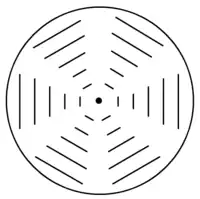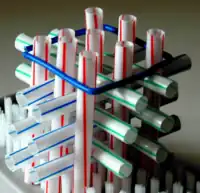A blue phase mode LCD is a liquid crystal display (LCD) technology that uses highly twisted cholesteric phases in a blue phase. It was first proposed in 2007 to obtain a better display of moving images with, for example, frame rates of 100–120 Hz to improve the temporal response of LCDs.[1] This operational mode for LCDs also does not require anisotropic alignment layers (e.g., rubbed polyimide) and thus theoretically simplifies the LCD manufacturing process.
History

In Reinitzer's reports from 1888 on the melting behaviour of cholesteryl benzoate, there is a note that the substance briefly turned blue as it changed from clear to cloudy upon cooling. This subtle effect remained unexplored for more than 80 years until experimental results were published during the late 1960s and early 1970s that indicated that the blue color was due to at least two new and very different liquid crystalline phases.[2]
For almost 100 years, scientists assumed that the most stable cholesteric helical structure could be described by a single helical axis about which the director rotates. It turned out that in the new structure the director rotates in a helical fashion about any axis perpendicular to a line as illustrated in fig. 1. Although an unlimited number of helical axes are actually present, this structure was named double twist structure.

This double twist structure is more stable than the single twist structure (i.e., the normal helical structure of chiral nematics) only up to a certain distance from the line at the center. Since this distance is on the order of the pitch of the chiral nematic liquid crystal (typically 100 nm) and since the geometries of usual liquid crystal samples are much larger, the double twist structure occurs only rarely.

Blue phases are special cases when double twist structures fill up large volumes. When double twist structures are limited in all directions to the distance from the center line where the twist amounts to 45° a double twist cylinder results. Because of its small radius, such a cylinder is more stable than the same volume filled with a single twist chiral nematic liquid crystal.

A large structure can be composed from these double twist cylinders, but defects occur at the points where the cylinders are in contact as illustrated in fig. 5.[3] These defects occur at regular distances and tend to make the structure less stable, but it is still slightly more stable than the single twist structure without defects, at least within a temperature range of about 1 K below the transition from the chiral nematic phase to an isotropic liquid.
The defects that occur at regular distances in three spatial dimensions form a cubic lattice just as we know it from solid crystals. Blue phases are thus formed by a regular three-dimensional lattice of defects within a chiral liquid crystal. Since the spacings between the defects of a blue phase are in the range of the wavelength of light (several hundred nanometers), for certain wavelength ranges of the light reflected from the lattice constructive interference occurs (Bragg reflection) and the blue phase reflects colored light (note that only some of the blue phases actually reflect blue light).[4]

_and_II_(right)..jpg.webp)
Wide temperature range blue phases
In 2005, researchers from the Centre of Molecular Materials for Photonics and Electronics at the University of Cambridge reported their discovery of a class of blue-phase liquid crystals that remain stable over a range of temperatures as wide as 16-60 °C.[5] The researchers showed that their ultrastable blue phases could be used to switch the color of the reflected light by applying an electric field to the material, and that this could eventually be used to produce three-color (red, green, and blue) pixels for full-color displays.[6] The new blue phases are made from molecules in which two stiff, rod-like segments are linked by a flexible chain, and are believed to be stabilized due to flexoelectricity.[7]
Furthermore, electro-optical switching with response times of the order of 10−4 s for the stabilized blue phases at room temperature has been shown.[8]
Blue Phase crystals are regarded as 3D photonic crystals, as they possess a periodic cubic structure in the nanometer range with a selective bandgap in the visible wavelengths. However, standard blue phase crystal manufacturing produces polycrystalline samples, the single crystal size being in the micrometer range. Recently, blue phases obtained as ideal 3D photonic crystals in large volumes have been stabilized with a controlled crystal lattice orientation.[9]
Electro-optical switching from monocrystalline blue phases show increased modulation and less scattering than in polycrystalline samples [10]
First blue phase LC-display
In May, 2008 Samsung Electronics announced that it has developed the world's first Blue Phase LCD panel which can be operated at an unprecedented refresh rate of 240 Hz. Samsung unveiled a 15 inch prototype model of its Blue Phase LCD panel at the SID (Society for Information Display) 2008 international Symposium, Seminar and Exhibition, which was held in Los Angeles from May 18 to 23, 2008.[11]
Developed with a look at cost-efficiency, Samsung's Blue Phase mode does not require liquid crystal alignment layers, unlike today's most widely used TFT LCD modes such as Twisted Nematic (TN), In-Plane Switching (IPS) or Vertical Alignment (VA). The Blue Phase mode can make its own alignment layers, eliminating the need for any mechanical alignment and rubbing processes. This reduces the number of required manufacturing steps, resulting in savings on production costs. Additionally it has been claimed that Blue Phase panels would reduce the sensitivity of the liquid crystal layer to mechanical pressure which could impair the lateral uniformity of display (e.g. luminance, chromaticity).
In a blue phase based LC-display for TV applications it is not the selective reflection of light according to the lattice pitch (Bragg reflection) that is used for display of visual information, but an external electric field induces a birefringence in the liquid crystal via the Kerr effect.[12] That field induced birefringence becomes apparent as a change of transmission when the Blue Phase Mode LC layer is placed between crossed polarizers.
For a detailed discussion of the blue phase LCs in in-plane switching (IPS) structures and related modeling method based on the Kerr effect in a macroscopic scale see references.[13][14] With an isotropic dark state, blue phase LCDs show many interesting electro-optic performances. Presently, the driving voltage of blue phase LCs in IPS structures is still a little bit too high. To reduce the voltage, material engineering for developing high Kerr constant mixtures is critically important.[15] Moreover, device design is also an effective way. With proper device structure design, the driving voltage can be largely reduced.[16]
See also
References
- ↑ Kikuchi, Hirotsugu; Higuchi, Hiroki; Haseba, Yasuhiro; Iwata, Takashi (2007). "Fast Electro-Optical Switching in Polymer-Stabilized Liquid Crystalline Blue Phases for Display Application". SID Symposium Digest of Technical Papers. Wiley. 38 (1): 1737–1740. doi:10.1889/1.2785662. ISSN 0097-966X. S2CID 136035580.
- ↑ Timothy J. Sluckin, David A. Dunmur, Horst Stegemeyer: Crystals That Flow - Classic Papers from the History of Liquid Crystals, Liquid Crystals Series, Taylor & Francis London 2004, ISBN 0-415-25789-1
- ↑ Lavrentovich, O. D.; Kleman, M. (2001). "Cholesteric Liquid Crystals: Defects and Topology". Chirality in Liquid Crystals. New York: Springer-Verlag. pp. 115–158. doi:10.1007/0-387-21642-1_5. ISBN 0-387-98679-0.
- ↑ Peter J. Collings, Liquid Crystals - Natures Delicate Phase of Matter, Adam Hilger, Bristol, 1990
- ↑ Coles, Harry J.; Pivnenko, Mikhail N. (2005). "Liquid crystal 'blue phases' with a wide temperature range". Nature. Springer Science and Business Media LLC. 436 (7053): 997–1000. doi:10.1038/nature03932. ISSN 0028-0836. PMID 16107843. S2CID 4307675.
- ↑ Yamamoto, Jun; Nishiyama, Isa; Inoue, Miyoshi; Yokoyama, Hiroshi (2005). "Optical isotropy and iridescence in a smectic 'blue phase'". Nature. Springer Science and Business Media LLC. 437 (7058): 525–528. doi:10.1038/nature04034. ISSN 0028-0836. PMID 16177785. S2CID 4432184.
- ↑ Castles, F.; Morris, S. M.; Terentjev, E. M.; Coles, H. J. (2010-04-13). "Thermodynamically Stable Blue Phases". Physical Review Letters. 104 (15): 157801. arXiv:1101.5588. doi:10.1103/physrevlett.104.157801. ISSN 0031-9007. PMID 20482018. S2CID 4665796.
- ↑ Kikuchi, Hirotsugu; Yokota, Masayuki; Hisakado, Yoshiaki; Yang, Huai; Kajiyama, Tisato (2002). "Polymer-stabilized liquid crystal blue phases". Nature Materials. Springer Nature. 1 (1): 64–68. doi:10.1038/nmat712. ISSN 1476-1122. PMID 12618852. S2CID 31419926.
- ↑ Otón, Eva; Yoshida, Hiroyuki; Morawiak, Przemysław; Strzeżysz, Olga; Kula, Przemysław; Ozaki, Masanori; Piecek, Wiktor (2020-06-23). "Orientation control of ideal blue phase photonic crystals". Scientific Reports. 10 (1): 10148. doi:10.1038/s41598-020-67083-6. ISSN 2045-2322. PMC 7311397. PMID 32576875.
- ↑ Oton, E.; Netter, E.; Nakano, T.; D.-Katayama, Y.; Inoue, F. (April 2017). "Monodomain Blue Phase Liquid Crystal Layers for Phase Modulation". Scientific Reports. 7 (1): 44575. doi:10.1038/srep44575. ISSN 2045-2322. PMC 5345094. PMID 28281691.
- ↑ Samsung Develops World's First 'Blue Phase' Technology to Achieve 240 Hz Driving Speed for High-Speed Video (access date 23 April 2009)
- ↑ Haseba, Yasuhiro; Kikuchi, Hirotsugu (2006). "Electro-optic effects of the optically isotropic state induced by the incorporative effects of a polymer network and the chirality of liquid crystal". Journal of the Society for Information Display. Wiley. 14 (6): 551–556. doi:10.1889/1.2210806. ISSN 1071-0922. S2CID 62135317.
- ↑ Ge, Zhibing; Gauza, Sebastian; Jiao, Meizi; Xianyu, Haiqing; Wu, Shin-Tson (2009-03-09). "Electro-optics of polymer-stabilized blue phase liquid crystal displays". Applied Physics Letters. AIP Publishing. 94 (10): 101104. doi:10.1063/1.3097355. ISSN 0003-6951. Archived from the original on 2012-07-13. Retrieved 2019-12-05.
- ↑ Ge, Zhibing; Rao, Linghui; Gauza, Sebastian; Wu, Shin-Tson (2009). "Modeling of Blue Phase Liquid Crystal Displays". Journal of Display Technology. Institute of Electrical and Electronics Engineers (IEEE). 5 (7): 250–256. doi:10.1109/jdt.2009.2022849. ISSN 1551-319X. S2CID 2643470.
- ↑ Rao, Linghui; Yan, Jin; Wu, Shin-Tson; Yamamoto, Shin-ichi; Haseba, Yasuhiro (2011-02-21). "A large Kerr constant polymer-stabilized blue phase liquid crystal". Applied Physics Letters. AIP Publishing. 98 (8): 081109. doi:10.1063/1.3559614. ISSN 0003-6951. S2CID 120451019. Archived from the original on 2013-07-03. Retrieved 2019-12-05.
- ↑ Rao, Linghui; Ge, Zhibing; Wu, Shin-Tson; Lee, Seung Hee (2009-12-07). "Low voltage blue-phase liquid crystal displays". Applied Physics Letters. AIP Publishing. 95 (23): 231101. doi:10.1063/1.3271771. ISSN 0003-6951.
Further reading
- O.D. Lavrentovich, M. Kleman: Defects and Topology of Cholesteric Liquid Crystals" in "Chirality in Liquid Crystals, 5", Springer Verlag: New York (2001), excerpt available here.
See page 124, Figure 5.4 for details on the disclination formed in the gusset (i.e., triangular area where three double twist cylinders are in contact).